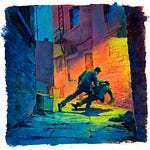The bus, when it pulled up, wasn’t what I expected. For a vehicle hired to take a rowdy bunch of Indian schoolboys, their severe football coach and support staff, and a skinny white boy on exchange deep into the foothills of the Himalayas, it didn’t look fit for service. Replete with the luxuries favored by local drivers - plump red beads hanging from the interior, psychadelic blankets draped over the seats, Ganesha and his benevolent, trunky smile dangling from the rear-view mirror - it was also missing a door, several window panes and the driver himself looked slightly mad. Thick, oversized frames magnified his eyes, which peered out over smooth, wobbly cheeks. His hair was receding, giving his gaunt throat and clavicle a disjointed appearance. The man and the machine were a strange, organic entity in themselves, cut from the same cloth as the rest of India’s lassaiz-faire world of mercenary drivers, pilots and hawkers. I swallowed.
“Ohhh, this guy is crazy,” laughed one of my teammates as the vehicle pulled in. They knew this driver, had been taken around Uttar Pradesh by him before. This was not calming. I was used to professional drivers who drove whatever bus they were given each day, had license requirements, standardized training and first aid experience. Even though I was attending one of the best schools in India, I had experienced first hand the volatile realities of hiring help in this jumbling, sprawling country. One tour guide that had taken us around Agra a few weeks earlier had randomly left us - two unseasoned sixteen year old boys - for an entire day, doubtless to take care of some urgent business. It’s never personal. Everyone’s busy, has multiple enterprises, is trying to make ends meet in a particularly chaotic corner of the world.
So, we choofed off toward The Lawrence School, Sanawar, up through a long, high valley from Dehradun. You’ve heard of the roads we chugged up a thousand times before, on some other adventurer’s vagabond travels; barely wide enough for two cars, potholed and zero barriers protecting you from the valley below. The driver didn’t slow down, weaving around cars and braking, the bus (and my neck) jarringly responsive to his impatient foot. I looked through the hole where the door was and saw nothing but mist clinging to the bottom of the Shiwalik hills. If we tumbled from the road, there was no way to know how far or long the bus would fall for.
It was about two hours from Sanawar that I smelt the ganja. In Indian parlance back then, a distinction is made between cannabis, the flower and resin of the plant, and ceremonial usages such as bhang, cannabis leaves crushed and mixed with milk. One of my schoolmates had giggled when he told me about drinking bhang with his parents one year, not realising that the leaves came from the same plant as the ganja. The arbitrariness of it all was not lost on the boy, the anatomy of the flower carved up between the law and the land.
The odor was definitely of the illegal sort, and it turned out it was wafting from the driver’s compartment, a slow-burning cherry at the end of a comically thick blunt rolling around in his lips. Panicked at how precarious the situation was becoming, I looked toward the adults. They were staring serenely out the windows at the lush green hills, save for one. He was sitting in the passenger seat, talking amiably with the driver. There was no one to appeal to. All I could do was stare at where the door should have been and wonder how many times my body would turn through the air when we pitched over the side. I needn’t have worried. Of course there was nothing to worry about. This was his bus. This was his machine. Everyone but me knew it. And of course, he sucked on a blunt the whole way back, five days later.
No one knew his bus like he did, beads, blankets and all. Except maybe Ganesha.
Car
What I didn’t know then was that the driver was inside the bus. Not literally, or in any ghostly sense, but inside in the same way you might grow a feel for your own car. Every car comes off the conveyor belt the same, but grows differently with its owner and environment. I used to own a blue Holden Commodore, which we called the Blue Whale because of the otherworldly moans the steering yoke made. The alternator would give out, the transformer was on its last legs, and I couldn’t accelerate too quickly or it would threaten to choke out altogether. I developed a feel for these quirks toward the end of its life, could sense exactly how much weight to put on the accelerator, when to thrash it to get over a tough incline, how responsive the steering was and how long it would take to brake. I was guiding the old man to the end, prolonging his life by easing around his edges. I couldn’t describe it, exactly - I just knew. I was inside the car.
I’m describing this feeling with language. Language is a supreme technology that allows us to use its code to enunciate what is happening, and our thoughts about what is happening. There is no other way for us to explicate our own thoughts, and to learn instruction on abstract ideas. Dan Dennett said about language’s evolutionary effect
“There is no step more uplifting, more momentous in the history of mind design, than the invention of language. When Homo sapiens became the beneficiary of this invention, the species stepped into a slingshot that has launched it far beyond all other earthly species.”
But telling you about the car isn’t the same as being inside it.
Plane
The Hongkongese are used to typhoons; not me. The day an level eight typhoon hit, the city methodically shut down, I queued up on the phone to the airline to rebook my departure to Manila, and watched the metropolis turn into a ghost town. The drive to the airport the next morning was serene, surreal. The day felt like a coiled spring, beautiful and dry, none of the listlessness that hung over the city as the typhoon had approached the day before. I was impatient for the next leg of my little tour, mostly ignoring the glass and tree debris that still littered Hong Kong’s boulevards.
Naturally, we flew straight back into the passing typhoon halfway to Manila. I was not a good flier back then. As the cabin began to shake, and the flight attendants wobbled down the aisles, I started squirming in my seat as my palms grew sweaty and my mind scrabbled to find something to distract or grasp to. I got up to go to the bathroom and felt temporary relief. At least I could control my body. But then the intercom came over, an automated voice calmly telling us to return to our seats and fasten our seatbelts. The severity of the situation became more apparent as the captain’s voice, perhaps unaware of the announcement, perhaps trying to put an exclamation mark on the point, came over. “Please return to your seats!” he barked.
Whooooosh. The plane hit an air pocket and dropped. I looked toward an attendant, searching for a barometer for how concerned I should be. She looked concerned. I felt panic bubbling in my stomach. The plane began swinging back and forth in the violence of the storm, the tipping of the wings punctuated with gasps and muffled screams from the passengers (possibly mine). This was easily my worst nightmare - any bad flier’s nightmare - trapped on a plane with nowhere to go but through.
Then, finally, in the eye of the storm and the worst of the turbulence, my mind went quiet. The recursive thinking and grasping for control gave up, and I surrendered to the situation. I wasn’t expecting it. All by itself, my brain realised there was nothing it could do, that all the thinking and worrying served only to perpetuate its own neurosis and on the worst flight I’ve ever been on, I completely gave myself over to the pilot and his plane. We emerged, forty-five minutes later, to begin a steady descent to Manila.
Going inside technology is a feeling. Mastering a technology is a feeling we call intuition. Intuition is discarding the need for instruction. When we go deep into technology, our neurons fuse with reality and words and thoughts become pointless. A pilot spends tens of thousands of hours in a simulator before taking a real load of people to the skies, because they need to have a feel for the vehicle.
Grazing
The tractor beam of technology invites us to graze widely, rather than plunge into it. This is because attention and human love of novelty combines with the market to make our focus highly profitable. There are huge commercial incentives to draw our gaze and hold it to a screen, including at work. Modern knowledge workers check communication tools every 6 minutes, 10 times an hour. Messenger chats are now embedded in our environments, notifying workers of the ceaseless, frenetic activity of their fellow employees (I am still triggered by the ga-dump of a Microsoft Teams notification). Checking in and reacting to messages is now a significant part of being a knowledge worker. I’ve turned into a radar, constantly scanning for new information to react to.
Cal Newport calls this shallow work. Shallow work is reactive and unsatisfying because switching our attention carries a cost - we are not multi-tasking creatures, and lost focus results in a decrease of quality in both the task we were doing, and the task we’re switch to. I think AI could make deep work even harder. Now, we can develop ideas by switching between agents, prompting and improving the responses we get from Claude and Deepseek, and apply them to the third, actual thing we’re supposed to be doing. In doing so, we’re cutting out the kind of activity that requires us to think about a problem, kick it around, examine it from all angles, maybe even go for a walk and flip it like a pancake in our brains. We’re doing the opposite of what the mirror neurons in our brain crave; to transcend the endless instructing chatter of our minds, peacefully bury ourself into the world, and try to produce new, valuable creations. We’re building a culture of endless, endless breadth, its informational horizons stretching east to west.
But we’re not going inside it. We’re skimming our attention across its surface.
We’re diminishing the pleasure and value of depth, of having such an intuitive grasp of our world that we can suck back a blunt at the helm of some great machine, and simply enjoy the ride.

















Share this post